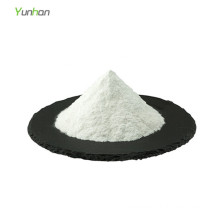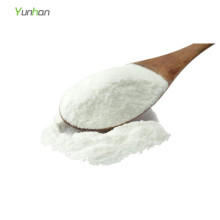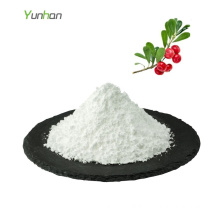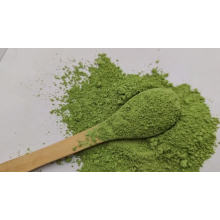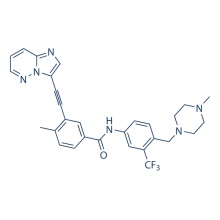GNF-2 778270-11-4
Product Description
.cp_wz table {border-top: 1px solid #ccc;border-left:1px solid #ccc; } .cp_wz table td{border-right: 1px solid #ccc; border-bottom: 1px solid #ccc; padding: 5px 0px 0px 5px;} .cp_wz table th {border-right: 1px solid #ccc;border-bottom: 1px solid #ccc; padding: 5px 0px 0px 5px;}
Molecular Weight:
374.32 GNF-2 is a highly selective non-ATP competitive inhibitor of Bcr-Abl, shows no activity to Flt3-ITD, Tel-PDGFR, TPR-MET and Tel-JAK1 transformed tumor cells.
Biological Activity
GNF-2 causes a dose-dependent growth inhibition of the Bcr-abl–positive
cell lines with IC50 values of 273 nM (K562) and 268 nM (SUP-B15). GNF-2
inhibits the growth of Ba/F3.p210E255V and Ba/F3.p185Y253H cells with IC50 values of 268 nM and 194 nM respectively. GNF-2 (1 μM)
induces Apoptosis of Ba/F3.p210 cells as well as Ba/F3.p210E255V cells. GNF-2 inhibits the cellular tyrosine phosphorylation of Bcr-abl
in a dose-dependent manner with IC50 of 267 nM. GNF-2 (1 μM) induces a
significant decrease in the levels of phospho-Stat5 in Ba/F3.p210 cells.
GNF-2 binds to the myristic binding pocket of Bcr-abl. GNF-2 inhibits the kinase activity of non-myristoylated c-Abl more
potently than that of myristoylated c-Abl by binding to the
myristate-binding pocket in the C-lobe of the kinase domain. GNF-2 (10
μM) requires BCR and/or the c-Abl SH3 and/or SH2 domains to inhibit
BCR-Abl-dependent cell proliferation. GNF-2, but not a methylated GNF-2
analog, binds c-Abl in cellular extracts derived from 3T3 fibroblasts.
GNF-2 (10 μM), in a dose-dependent manner, clearly inhibits tyrosine
phosphorylation of CrkII.
GNF-2 inhibits the phosphorylation of CrkII in
c-AblG2A-expressing cells with IC50 of 0.051 μM. GNF-2
binds in an extended conformation in the myristate pocket with the
CF3-group buried at the same depth as the final two carbons of the
myristate ligand. GNF-2 (10 µM) combined with imatinib (1 µM) reduces
the number of resistant clones to 1 µM imatinib by at least 90%. GNF-2 inhibits the auto-phosphorylation and proliferation of BafF3
cells expressing p210Bcr–Abl and p210Bcr–Abl mutants. GNF-2 (8 nM) in
combination with GNF-5 (20 nM) results in additive effects with respect
to inhibition of the Abl64–515 kinase activity.
Protocol(Only for Reference)
Kinase Assay: [2]
Cell Assay: [1]
Conversion of different model animals based on BSA (Value based on data from FDA Draft Guidelines)
For example, to modify the dose of resveratrol used for a mouse (22.4 mg/kg) to a dose based on the BSA for a rat, multiply 22.4 mg/kg by the Km factor for a mouse and then divide by the Km factor for a rat. This calculation results in a rat equivalent dose for resveratrol of 11.2 mg/kg.
Chemical Information
Molarity Calculator
Dilution Calculator
Molecular Weight Calculator
Contact us if you need more details on 778270-11-4. We are ready to answer your questions on packaging, logistics, certification or any other aspects about GNF-2 778270-11-4、778270-11-4 GNF-2. If these products fail to match your need, please contact us and we would like to provide relevant information.
Molecular Weight:
374.32 GNF-2 is a highly selective non-ATP competitive inhibitor of Bcr-Abl, shows no activity to Flt3-ITD, Tel-PDGFR, TPR-MET and Tel-JAK1 transformed tumor cells.
Biological Activity
GNF-2 causes a dose-dependent growth inhibition of the Bcr-abl–positive
cell lines with IC50 values of 273 nM (K562) and 268 nM (SUP-B15). GNF-2
inhibits the growth of Ba/F3.p210E255V and Ba/F3.p185Y253H cells with IC50 values of 268 nM and 194 nM respectively. GNF-2 (1 μM)
induces Apoptosis of Ba/F3.p210 cells as well as Ba/F3.p210E255V cells. GNF-2 inhibits the cellular tyrosine phosphorylation of Bcr-abl
in a dose-dependent manner with IC50 of 267 nM. GNF-2 (1 μM) induces a
significant decrease in the levels of phospho-Stat5 in Ba/F3.p210 cells.
GNF-2 binds to the myristic binding pocket of Bcr-abl. GNF-2 inhibits the kinase activity of non-myristoylated c-Abl more
potently than that of myristoylated c-Abl by binding to the
myristate-binding pocket in the C-lobe of the kinase domain. GNF-2 (10
μM) requires BCR and/or the c-Abl SH3 and/or SH2 domains to inhibit
BCR-Abl-dependent cell proliferation. GNF-2, but not a methylated GNF-2
analog, binds c-Abl in cellular extracts derived from 3T3 fibroblasts.
GNF-2 (10 μM), in a dose-dependent manner, clearly inhibits tyrosine
phosphorylation of CrkII.
GNF-2 inhibits the phosphorylation of CrkII in
c-AblG2A-expressing cells with IC50 of 0.051 μM. GNF-2
binds in an extended conformation in the myristate pocket with the
CF3-group buried at the same depth as the final two carbons of the
myristate ligand. GNF-2 (10 µM) combined with imatinib (1 µM) reduces
the number of resistant clones to 1 µM imatinib by at least 90%. GNF-2 inhibits the auto-phosphorylation and proliferation of BafF3
cells expressing p210Bcr–Abl and p210Bcr–Abl mutants. GNF-2 (8 nM) in
combination with GNF-5 (20 nM) results in additive effects with respect
to inhibition of the Abl64–515 kinase activity.
Protocol(Only for Reference)
Kinase Assay: [2]
| Binding assay | Recombinant Proteins (100 nM for each construct) or immunoprecipitated proteins are diluted in kinase buffer (20 mM HEPES (pH 7.4), 50 mM KCl, 0.1% CHAPS, 30 mM MgCl2, 2 mM MnCl2, 1 mM DTT, and 1% glycerol). Aliquots of the diluted proteins are preincubated with either DMSO or compounds for 30 min at room temperature and then added to K-LISA PTK EAY reaction plates. The kinase reaction is initiated by adding 0.1 mM ATP and is allowed to proceed for 30 min at room temperature. The phosphorylation of GST-Abltide is monitored by SDS-PAGE and phosphorimaging analysis or autoradiography. |
|---|
Cell Assay: [1]
| Cell lines | Ba/F3.p210, Ba/F3.p210E255V and Ba/F3.p185Y253H cells |
|---|---|
| Concentrations | ~10 μM |
| Incubation Time | 48 hours |
| Method | Cells (0.3-0.6 × 106 per mL) are plated in duplicate or triplicate in 96-well plates containing increasing GNF-2 concentrations (5 nM–10 μM). After incubation at 37 ℃ in 5% CO2 for 48 hours, the effect of GNF-2 on cell viability is determined by the MTT colorimetric dye reduction method. Inhibition of cell proliferation is calculated as a percentage of growth of DMSO-treated cells, and IC50 values are determined with Microsoft Excel XLfit3. |
Conversion of different model animals based on BSA (Value based on data from FDA Draft Guidelines)
| Species | Baboon | Dog | Monkey | Rabbit | Guinea pig | Rat | Hamster | Mouse |
| Weight (kg) | 12 | 10 | 3 | 1.8 | 0.4 | 0.15 | 0.08 | 0.02 |
| Body Surface Area (m2) | 0.6 | 0.5 | 0.24 | 0.15 | 0.05 | 0.025 | 0.02 | 0.007 |
| Km factor | 20 | 20 | 12 | 12 | 8 | 6 | 5 | 3 |
| Animal A (mg/kg) = Animal B (mg/kg) multiplied by | Animal B Km |
| Animal A Km |
For example, to modify the dose of resveratrol used for a mouse (22.4 mg/kg) to a dose based on the BSA for a rat, multiply 22.4 mg/kg by the Km factor for a mouse and then divide by the Km factor for a rat. This calculation results in a rat equivalent dose for resveratrol of 11.2 mg/kg.
| Rat dose (mg/kg) = mouse dose (22.4 mg/kg) × | mouse Km(3) | = 11.2 mg/kg |
| rat Km(6) |
Chemical Information
| Molecular Weight (MW) | 374.32 |
|---|---|
| Formula | C18H13F3N4O2 |
| CAS No. | 778270-11-4 |
| Storage | 3 years -20℃Powder |
|---|---|
| 6 months-80℃in solvent (DMSO, water, etc.) | |
| Synonyms | |
| Solubility (25°C) * | In vitro | DMSO | 74 mg/mL (197.69 mM) |
|---|---|---|---|
| Water | <1 mg/mL ( | ||
| Ethanol | <1 mg/mL ( | ||
| * <1 mg/ml means slightly soluble or insoluble. * Please note that Selleck tests the solubility of all compounds in-house, and the actual solubility may differ slightly from published values. This is normal and is due to slight batch-to-batch variations. | |||
| Chemical Name | Benzamide, 3-[6-[[4-(trifluoromethoxy)phenyl]amino]-4-pyrimidinyl]- |
|---|
Molarity Calculator
Dilution Calculator
Molecular Weight Calculator
Contact us if you need more details on 778270-11-4. We are ready to answer your questions on packaging, logistics, certification or any other aspects about GNF-2 778270-11-4、778270-11-4 GNF-2. If these products fail to match your need, please contact us and we would like to provide relevant information.
Product Categories : Angiogenesis > Bcr-Abl Inhibitor
Other Products
Hot Products
Astragaloside AChlortetracycline HCl 64-72-2Paclitaxel 33069-62-4Dexamethasone Acetate 1177-87-3Dinaciclib (SCH727965) 779353-01-4CHIR-124 405168-58-3Ro3280 1062243-51-9TAME 901-47-3CCG-1423 285986-88-110058-F4 403811-55-2Dabigatran (BIBR 953) 211914-51-1H 89 2HCl 130964-39-5T0901317 293754-55-9Aprepitant 170729-80-3Turofexorate Isopropyl (XL335) 629664-81-9BMS-378806 357263-13-9

